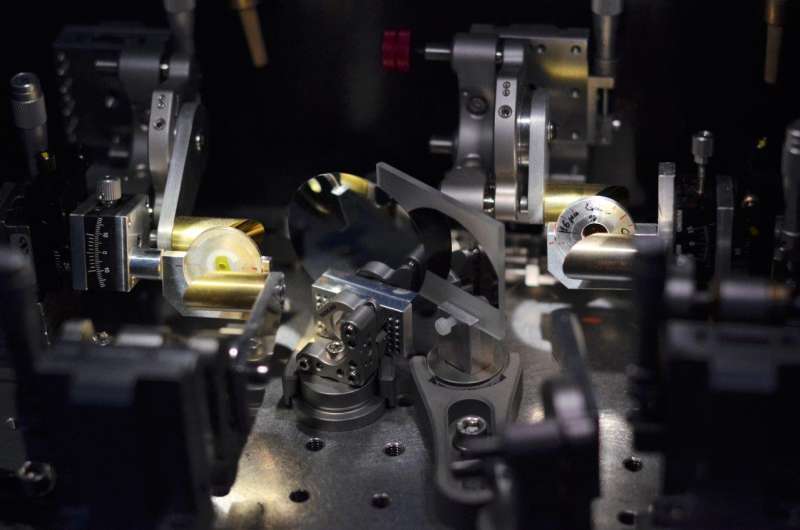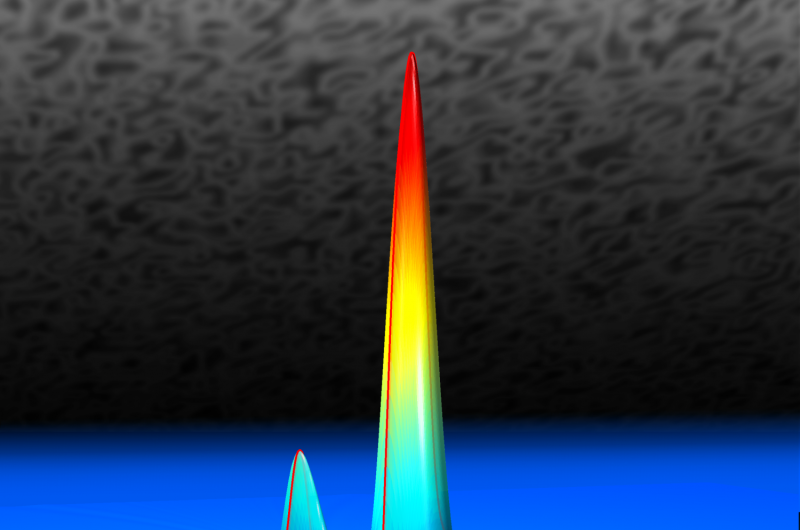Studying the quantum vacuum: Traffic jam in empty space

An important step towards a completely new experimental access to quantum physics has been made at University of Konstanz. The team of scientists headed by Professor Alfred Leitenstorfer has now shown how to manipulate the electric vacuum field and thus generate deviations from the ground state of empty space which can only be understood in the context of the quantum theory of light.
With these results, the researchers from the field of ultrafast phenomena and photonics build on their earlier findings, published in October 2015 in the scientific journal Science, where they have demonstrated direct detection of signals from pure nothingness. This essential scientific progress might make it possible to solve problems that physicists have grappled with for a long time, ranging from a deeper understanding of the quantum nature of radiation to research on attractive material properties such as high-temperature superconductivity. The new results are published on 19 January 2017 in the current online issue of the scientific journal Nature.
A world-leading optical measurement technique, developed by Alfred Leitenstorfer's team, made this fundamental insight possible. A special laser system generates ultrashort light pulses that last only a few femtoseconds and are thus shorter than half a cycle of light in the investigated spectral range. One femtosecond corresponds to the millionth of a billionth of a second. The extreme sensitivity of the method enables detection of electromagnetic fluctuations even in the absence of intensity, that is, in complete darkness. Theoretically, the existence of these "vacuum fluctuations" follows from Heisenberg's Uncertainty Principle. Alfred Leitenstorfer and his team succeeded in directly observing these fluctuations for the first time and in the mid-infrared frequency range, where even conventional approaches to quantum physics have not worked previously.
The conceptual novelty of the experiments is that instead of the frequency-domain techniques used so far, the physicists from Konstanz accessed quantum statistics of light directly in the time domain. At a chosen point in time, electric field amplitudes are directly measured instead of analysing light in a narrow frequency band. Studying different points in time results in characteristic noise patterns that allow for detailed conclusions about the temporal quantum state of light. As the laser pulse propagates together with the quantum field under study, the Konstanz physicists can, so to speak, bring time to a stop. Ultimately, space and time, that is "space-time", behave absolutely equivalently in these experiments - an indication of the inherently relativistic nature of electromagnetic radiation.
As the new measurement technique neither has to absorb the photons to be measured nor amplify them, it is possible to directly detect the electromagnetic background noise of the vacuum and thus also the controlled deviations from this ground state, created by the researchers. "We can analyse quantum states without changing them in the first approximation", says Alfred Leitenstorfer. The high stability of the Konstanz technology is an important factor for the quantum measurements, as the background noise of their ultrashort laser pulses is extremely low.

By manipulating the vacuum with strongly focused femtosecond pulses, the researchers come up with a new strategy to generate "squeezed light", a highly nonclassical state of a radiation field. The speed of light in a certain segment of space-time is deliberately changed with an intense pulse of the femtosecond laser. This local modulation of the velocity of propagation "squeezes" the vacuum field, which is tantamount to a redistribution of vacuum fluctuations. Alfred Leitenstorfer compares this mechanism of quantum physics graphically with a traffic jam on the motorway: from a certain point on, some cars are going slower. As a result, traffic congestion sets in behind these cars, while the traffic density will decrease in front of that point. That means: when fluctuation amplitudes decrease in one place, they increase in another.
While the fluctuation amplitudes positively deviate from the vacuum noise at temporally increasing speed of light, a slowing down results in an astonishing phenomenon: the level of measured noise is lower than in the vacuum state - that is, the ground state of empty space.
The simple illustration with the traffic on a motorway, however, quickly reaches its limits: in contrast to this "classical physics" picture, where the number of cars remains constant, the noise amplitudes change completely differently with increasing acceleration and deceleration of space-time. In case of a moderate "squeezing", the noise pattern is distributed around the vacuum level fairly symmetrically. With increasing intensity, however, the decrease inevitably saturates toward zero. The excess noise that is accumulated a few femtoseconds later, in contrast, increases non-linearly - a direct consequence of the Uncertainty Principle's character as an algebraic product. This phenomenon can be equated with the generation of a highly nonclassical state of the light field, in which, for example, always two photons emerge simultaneously in the same volume of space and time.
The experiment conducted in Konstanz raises numerous new questions and promises exciting studies to come. Next, the physicists aim at understanding the fundamental limits of their sensitive detection method which leaves the quantum state seemingly intact. In principle, every experimental analysis of a quantum system would ultimately perturb its state. Currently, still a high number of individual measurements needs to be performed in order to obtain a result: 20 million repetitions per second. The physicists can not yet say with certainty whether it is a so-called "weak measurement" in conventional terms of quantum theory.
The new experimental approach to quantum electrodynamics is only the third method to study the quantum state of light. Now fundamental questions arise: What exactly is the quantum character of light? What actually is a photon? Concerning the last question, that much is clear to the Konstanz physicists: instead of a quantized packet of energy it is rather a measure for the local quantum statistics of electromagnetic fields in space-time.
More information: C. Riek et al, Subcycle quantum electrodynamics, Nature (2017). DOI: 10.1038/nature21024
Provided by University of Konstanz





















